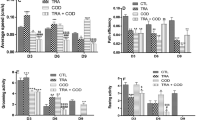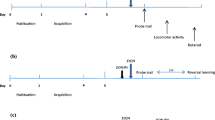Abstract
We aimed to review the literature to find the specific effect of opioids on the activity of cholinesterase (ChE) enzyme which plays a substantial role in the functioning of cholinergic system. Literature search was performed by two independent reviewers in order to find relevant articles about the changes in the activity of ChE in mice or rat following opioid administration. Based on findings from literature review, opioid administration is able to induce cholinergic modulation via decreasing or increasing the activity of ChE enzyme. However, the degree of variation of ChE in various brain regions is different. No gender differences was reported in the effect of opioids on ChE activity. Although chronic opioid administration may decrease enzyme function, ChE activity might be unchanged following opioid withdrawal using naloxone or the development of tolerance. Opioid type affects whether or not naloxone can reverse the changes of ChE. Direct inhibitory action of morphine and the other opioid ligands believed responsible for the decrease in the ChE activity. Moreover, the potency of codeine to induce allosteric enhancement of acetylcholine receptor signaling might be involved in the cholinergic modulation of codeine and other opioids. Animal studies on rat and mice showed that opioids may change the activity of ChE. These changes can pertain an increase or decrease in enzyme activity; as there might be no change. The type of opioid used may have an effect on the cholinergic modulation. It is beneficial to conduct cross-sectional and cohort studies on addicted individuals, especially opium abusers, to find the precise association of opioids with alterations in human acetyl cholinesterase or butyrylcholinesterase. Simulation studies can also examine the structure-function relationships and provide important details to better understand the mechanism of action of opioid compounds on ChE activity. In addition, understanding how opioids impact ChE activity may help perform proper interventions for drug abstinence.
Graphical abstract



Similar content being viewed by others
Data availability
The datasets used and analyzed during the current study are available from the corresponding author on request.
References
Abdel-Salam OM, Youness ER, Khadrawy YA, Sleem AA (2016) Acetylcholinesterase, butyrylcholinesterase and paraoxonase 1 activities in rats treated with cannabis, tramadol or both. Asian Pac J Trop Med 9:1089–1094
Assis CR, Linhares AG, Cabrera MP, Oliveira VM, Silva KC, Marcuschi M, Carvalho EVM, Bezerra RS, Carvalho LB (2018) Erythrocyte acetylcholinesterase as biomarker of pesticide exposure: new and forgotten insights. Environ Sci Pollut Res 25:18364–18376
Bailey DN, Briggs JR (2005) Studies of the inhibition of serum pseudocholinesterase activity in vitro by commonly used drugs. Am J Clin Pathol 124:226–228
Berterame S, Erthal J, Thomas J, Fellner S, Vosse B, Clare P, Hao W, Johnson DT, Mohar A, Pavadia J (2016) Use of and barriers to access to opioid analgesics: a worldwide, regional, and national study. Lancet 387:1644–1656
Bottoncetti A, Galli A (1987) Prevention of physostigmine-induced lethality by the opioid analgesic meptazinol in the mouse. Br J Pharmacol 91:299–306
Chen L, Sein M, Vo T, Amhmed S, Zhang Y, Hilaire K, Houghton M, Mao J (2014) Clinical interpretation of opioid tolerance versus opioid-induced hyperalgesia. J Opioid Manag 10:383–393
Dhananjayan V, Ravichandran B, Panjakumar K, Kalaiselvi K, Rajasekar K, Mala A, Avinash G, Shridhar K, Manju A, Wilson R (2019) Assessment of genotoxicity and cholinesterase activity among women workers occupationally exposed to pesticides in tea garden. Mutat Res Genet Toxicol Environ Mutagen 841:1–7
Draz EI, Hassan AM, Khalil HS, Elomary MA (2018) Evaluation of pelvic inflammatory disease potential in cholinesterase inhibitor pesticide-exposed females. Environ Sci Pollut Res 25:30818–30825
Elwy AE-HM, Tabl G (2017) Impact of tramadol and morphine abuse on the activities of acetylcholine esterase, Na+/K+-ATPase and related parameters in cerebral cortices of male adult rats. Electron Physician 9:4027–4034
Fisher SK, Wonnacott S (2012) Acetylcholine. In: Basic neurochemistry. Elsevier, Amsterdam
Gabadadze G, Kinle A (2006) Forensic-biochemical indices of serum amilase and cholinesterase activity in lethal poisoning with heroin. Sud Med Ekspert 49:23–25
Gibson A, Pollock D (1975) Reduction in the cholinesterase activity of the rat anococcygeus muscle produced by corticosterone. Br J Pharmacol 55:69–72
Gledhill LJ, Babey A-M (2021) Synthesis of the mechanisms of opioid tolerance: do we still say no? Cell Mol Neurobiol 41:927–948. https://doi.org/10.1007/s10571-021-01065-8
Hooijmans CR, Rovers MM, DE Vries RB, Leenaars M, Ritskes-Hoitinga M, Langendam MW (2014) SYRCLE’s risk of bias tool for animal studies. BMC Med Res Methodol 14:1–9
Howard R, Waljee J, Brummett C, Englesbe M, Lee J (2018) Reduction in opioid prescribing through evidence-based prescribing guidelines. JAMA Surg 153:285–287
Javed T, Habib R, Ghafoor S, Rumman B, Awan S, Ntepe LJ, Batool S, Nurulain SM (2019) Association of status of acetylcholinesterase and ACHE gene 3’UTR variants (rs17228602, rs17228616) with drug addiction vulnerability in pakistani population. Chem Biol Interact 308:130–136
Jitpakdee T, Mandee S (2014) Strategies for preventing side effects of systemic opioid in postoperative pediatric patients. Pediatr Anesth 24:561–568
Jóhannesson T (1962) Morphine as an inhibitor of brain cholinesterases in morphine-tolerant and non-tolerant rats. Acta Pharmacol Toxicol 19:23–35
Johnson N, Larson J, Meek E (2009) Handbook of toxicology of chemical warfare agents. Academic, San Diego
Kaur G, Kaur G (2001) Role of cholinergic and GABAergic neurotransmission in the opioids-mediated GnRH release mechanism of EBP-primed OVX rats. Mol Cell Biochem 219:13–19
Kieffer BL (2016) Drug discovery: designing the ideal opioid. Nature 537:170–171
Konecka A (1992) Effect of naloxone-reversible immobilization stress on the adrenal acetylcholinesterase activity in mice. Arch Int Physiol Biochim Biophys 100:143–145
Kotobuki H, Hiroshi K, Takeo K, Naohiko M (1964) Pharmacological studies of analgesics—VI: the administration of morphine and changes in acetylcholine metabolism mouse brain. Biochem Pharmacol 13:441–447
Mamaligas AA, Cai Y, Ford CP (2016) Nicotinic and opioid receptor regulation of striatal dopamine D2-receptor mediated transmission. Sci Rep 6:1–11
Miranda H, Moreu GM, Santiago P, Wolstenholme W (1987) Castration and tolerance induces changes in the levels of the activity of acetylcholinesterase in the isolated vas deferens of the rat. Neuropharmacology 26:1529–1534
Mohanakumar K, Sood P (1983) Acetylcholinesterase changes in the central nervous system of mice during the development of morphine tolerance addiction and withdrawal. Brain Res Bull 10:589–596
Mohanakumar K, Sood P (1986) Fluctuations of acetylcholinesterase in the mouse spinal cord and in vivo sodium effect during the development of morphine tolerance, dependence, and withdrawal. Neurochem Res 11:505–520
Moher D, Liberati A, Tetzlaff J, Altman DG, Group, P (2009) Preferred reporting items for systematic reviews and meta-analyses: the PRISMA statement. PLoS Med 6:e1000097
Mojtabai R (2018) National trends in long-term use of prescription opioids. Pharmacoepidemiol Drug Saf 27:526–534
Motel WC, Coop A, Cunningham CW (2013) Cholinergic modulation by opioid receptor ligands: potential application to Alzheimer’s disease. Mini-Rev Med Chem 13:456–466
Neugebauer NM, Einstein EB, Lopez MB, Mcclure-Begley TD, Mineur YS, Picciotto MR (2013) Morphine dependence and withdrawal induced changes in cholinergic signaling. Pharmacol Biochem Behav 109:77–83
Oriaku E, Soliman K (1989) Effect of morphine on the rat gastrointestinal cholinergic enzymes. Arch Int Pharmacodyn Ther 297:166–177
Osman NI, Baghdoyan HA, Lydic R (2005) Morphine inhibits acetylcholine release in rat prefrontal cortex when delivered systemically or by microdialysis to basal forebrain. J Am Soc Anesthesiologists 103:779–787
Pade PA, Cardon KE, Hoffman RM, Geppert CM (2012) Prescription opioid abuse, chronic pain, and primary care: a co-occurring disorders clinic in the chronic disease model. J Subst Abus Treat 43:446–450
Pandanaboina SC, Rajbanshi S, Kunala PN, Pandanaboina S, Pandanaboina MM, Gopalreddy V, Wudayagiri R (2012) Tramadol safety-cholinergic system of rat brain without nociception. Acta Pol Pharm 69:833–841
Rasool M, Malik A, Waquar S, Tul-Ain Q, Jafar TH, Rasool R, Kalsoom A, Ghafoor MA, Sehgal SA, Gauthaman K (2018) In-silico characterization and in-vivo validation of Albiziasaponin-A, Iso-Orientin, and Salvadorin using a rat model of Alzheimer’s disease. Front Pharmacol 9:730
Rose R, Kumar A, Bhattacharya S (1979) Striatal cholinergic activity during morphine-induced catalepsy in the rat: development of tolerance. Neurosci Lett 14:115–118
Schiller EY, Goyal A, Mechanic OJ (2020) Opioid overdose. StatPearls Publishing, Treasure Island
Schuster D, Spetea M, Music M, Rief S, Fink M, Kirchmair J, Schütz J, Wolber G, Langer T, Stuppner H (2010) Morphinans and isoquinolines: acetylcholinesterase inhibition, pharmacophore modeling, and interaction with opioid receptors. Bioorg Med Chem 18:5071–5080
Sivanesan E, Gitlin MC, Candiotti KA (2016) Opioid-induced hallucinations: a review of the literature, pathophysiology, diagnosis, and treatment. Anesth Analg 123:836–843
Türkan F (2021) Investigation of the toxicological and inhibitory effects of some benzimidazole agents on acetylcholinesterase and butyrylcholinesterase enzymes. Arch Physiol Biochem 127:97–101
Uddin MS, Rashid M (2020) Advances in neuropharmacology: drugs and therapeutics. CRC Press, Boca Raton
Volkow ND, Mclellan AT (2016) Opioid abuse in chronic pain—misconceptions and mitigation strategies. N Engl J Med 374:1253–1263
Vukšić A, Lovrić J, Konjevoda P, Blažević N, Bilušić M, Bradamante V (2019) Effects of simvastatin and fenofibrate on butyrylcholinesterase activity in the brain, plasma, and liver of normolipidemic and hyperlipidemic rats. Arh Hig Rada Toksikol 70:30–35
Wahba Z, Oriaku E, Soliman K (1987) Brain cholinergic involvement during the rapid development of tolerance to morphine. Pharmacology 34:66–73
Zhu Z, Bowman HR, Baghdoyan HA, Lydic R (2008) Morphine increases acetylcholine release in the trigeminal nuclear complex. Sleep 31:1629–1637
Author information
Authors and Affiliations
Contributions
HA and MS collected the data and analyzed the full text of publications; BR-Z, TF, and FF contributed in preparation of the manuscript, and MS made the first and final drafts of the manuscript. All authors reviewed and approved the final draft.
Corresponding author
Ethics declarations
Ethics approval and consent to participate
Not applicable.
Consent for publication
Not applicable.
Competing interests
The authors declare no competing interests.
Additional information
Responsible Editor: Mohamed M. Abdel-Daim
Publisher’s note
Springer Nature remains neutral with regard to jurisdictional claims in published maps and institutional affiliations.
Rights and permissions
About this article
Cite this article
Aramjoo, H., Riahi-Zanjani, B., Farkhondeh, T. et al. Modulatory effect of opioid administration on the activity of cholinesterase enzyme: a systematic review of mice/rat models. Environ Sci Pollut Res 28, 52675–52688 (2021). https://doi.org/10.1007/s11356-021-16044-1
Received:
Accepted:
Published:
Issue Date:
DOI: https://doi.org/10.1007/s11356-021-16044-1




